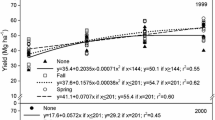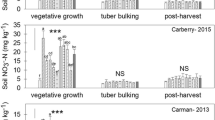Abstract
The release of three new potato (Solarium tuberosum L.) cultivars, Bannock Russet, Gem Russet, and Summit Russet, with unique plant growth characteristics, necessitates the development of appropriate N fertilizer recommendations. These three new cultivars, along with the standard cultivar, Russet Burbank, were treated with four N rates (0, 100, 200, and 300 kg N ha−1) using two different application timing procedures (“early,” with two-thirds N applied preplant, and “late,” with one-third applied preplant). Measurements included total and U.S. No. 1 yields, petiole NO3-N concentrations, and net returns derived from economic analysis using a processing-based contract. Each of the four cultivars showed a unique response to N application treatments. Bannock Russet achieved maximum yield and net returns with relatively small amounts of N fertilizer. It also showed no response to N application timing and had moderate NO3-N sufficiency concentrations early in the season, that decreased markedly late in the season. Gem Russet N requirement for maximum yield was similar to that of Russet Burbank, but required a higher amount of N for maximum net returns. Gem Russet also showed no response to application timing and had NO3-N sufficiency concentrations similar to or slightly higher than those of Russet Burbank. Summit Russet showed a strong trend for improved N use-efficiency when most of the N was applied early. On the other hand, analysis of net returns revealed a trend for greater profitability for Summit Russet when the majority of N was applied during tuber bulking. Petiole NO3-N sufficiency concentrations for Summit Russet were generally higher than those for the other three cultivars. In comparison with some earlier studies with Russet Burbank, this research suggested lower optimal N rates and petiole NO3-N sufficiency concentrations.
Resumen
La liberación de tres nuevos cultivares de papa (Solanum tuberosum L.), Bannock Russet, Gem Russet, y Summit Russet que tienen características únicas de crecimiento, requieren del desarrollo de recomendaciones apropiadas de fertilización nitrogenada. Estos tres nuevos cultivares junto con el cultivar estándar Russet Burbank, fueron tratados con tres dosis (0,100,200 y 300 Kg de N/ha−1) utilizando dos procedimientos de aplicación (“temprano,” con las dos terceras partes de nitrógeno aplicadas antes de la siembra y “tardio,” con la tercera parte de N aplicada antes de la siembra). Se tomó en cuenta el rendimiento total y el rendimiento de U.S. No. 1, concentración de NO3-N en los pecíolos y utilidades netas derivadas del análisis económico neto por contrato de procesamiento. Cada uno de los cuatro cultivares mostró una respuesta especial a los tratamientos de aplicación de N. Bannock Russet alcanzó un rendimiento máximo y utilidad neta con cantidades relativamente pequenas de fertilizante nitrogenado. No mostró respuesta a la época de aplicación de N y tuvo una moderada concentración de NO3-N en los inicios, la misma que fue decreciendo marcadamente hacia finales del período de cultivo. Los requerimientos de N de Gem Russet para un rendimiento máximo fueron similares a los de Russet Burbank pero necesitó una mayor cantidad de N para obtener una utilidad neta máxima. Gem Russet tampoco mostró respuesta a la época de aplicación y presentó suficiente concentratión de NO3-N similar o ligeramente superior a la de Russet Burbank. Summit Russet mostró una fuerte tendencia al uso de N cuando se aplicó con la modalidad de “temprano.rd Por otra parte, el análisis de utilidades netas reveló la tendencia de Summit Russet a una mayor utilidad, cuando la mayor cantidad de N se aplicó en la etapa de desarrollo del cultivo. Las concentraciones adecuadas de NO3-N en el pecíolo fueron generalmente mayores para Summit Russet que para los otros tres cultivares. Comparativamente con algunos estudios anteriores de Russet Burbank, esta investigacion sugiere el empleo de dosis mas bajas de N y de concentraciones adecuadas de NO3-N en el peciolo.
Similar content being viewed by others
Abbreviations
- N:
-
nitrogen
- NO3-N:
-
nitrate nitrogen
Literature Cited
Cataldo DA, M Haroon, LE Schrader, and VL Youngs. 1975. Rapid colorimetric determination of nitrate in plant tissue by titration of salicylic acid. Comm Soil Plant Sci 6:71–80.
Gardner BR, and JP Jones. 1975. Petiole analysis and the nitrogen fertilization of ‘Russet Burbank’ potatoes. Am Potato J 52:195–200.
Hutchinson PJS, DJ Tonks, and BR Beutler. 2003. Efficacy and economics of weed control programs in glyphosate-resistant potato (Solanum tuberosum). Weed Tech (in press).
Johnson CL, TA Tindall, M Thornton, and RA Brooks. 1995. Petiole NO3-N sufficiency curves in newly developed potato cultivars. Proc Univ Idaho Winter Commodity Schools 27:209–216.
Jones JP, and CG Painter. 1975. Tissue analysis, a guide to nitrogen fertilization of Idaho ‘Russet Burbank’ potatoes. Univ of Idaho Current Info Series No 240.
Keeney DR, and DW Nelson. 1982. Nitrogen-Inorganic forms.In: AL Page, RH Miller, and DR Keeney (eds), Methods of Soil Analysis, Part 2 Chemical and Microbiological Properties, 2nd Ed. ASA, SSSA, Inc., Madison, WI.
Kleinkopf GE, and DT Westermann. 1986. Scheduling nitrogen applications for Russet Burbank potatoes. Univ of Idaho Curr Info Series No 637.
Kleinkopf GE, DT Westermann, and RB Dwelle. 1981. Dry matter production and nitrogen utilization by six potato cultivars. Agron J 73:799–802.
Lauer DA 1986a. Response of Nooksack potatoes to nitrogen fertilizer. Am Potato J 63:251–262.
Lauer DA. 1986b. ‘Russet Burbank’ yield response to sprinkler-applied nitrogen fertilizer. Am Potato J 63:61–69.
Love SL, R Novy, DL Corsini, JJ Pavek, AR Mosley, RE Thornton, SR James, and DC Hane. 2002. ‘Gem Russet’: a long russet potato cultivar with excellent fresh market and french fry processing quality. Amer J Potato Res 79:25–31.
MacLean AA. 1984. Time of application of fertilizer nitrogen for potatoes in Atlantic Canada. Am Potato J 61:23–29.
MacMurdo W, RK Prange, and R Veinot. 1988. Nitrogen fertilization and petiole tissue testing in production of whole seed tubers of the potato cultivars Sebago and Atlantic. Can J Plant Sci 68:901–905.
Millard P, and B Marshall. 1986. Growth, nitrogen uptake and partitioning within the potato (Solanum tuberosum L.) crop, in relation to nitrogen application. J Agric Sci Camb 107:421429.
Millard P, and D. Robinson. 1990. Effect of the timing and rate of nitrogen fertilization on the growth and recovery of fertilizer nitrogen within the potato (Solanum tuberosum L.) crop. Fert Res 21:133–140.
Novy RG, DL Corsini, SL Love, JJ Pavek, AR Mosley, SR James, DC Hane, CC Shock, KA Rykbost, CR Brown, and RE Thornton. 2002. ‘Bannock Russet’: a dual-purpose russet potato cultivar with high U.S. No. 1 yield and multiple disease resistances. Amer J Potato Res 79:147–153.
Porter GA, and JA Sisson. 1991a. Petiole nitrate content of Mainegrown ‘Russet Burbank’ and ‘Shepody’ potatoes in response to varying nitrogen rates. Am Potato J 68:493–505.
Porter GA, and JA Sisson. 1991b. Response of ‘Russet Burbank’ and ‘Shepody’ potatoes to nitrogen fertilizer in two cropping systems. Am Potato J 68:425443.
Roberts S, and AI Dow. 1982. Critical nutrient ranges for petiole phosphorus levels of sprinkler-irrigated ‘Russet Burbank’ potatoes. Agron J 74:583–585.
Roberts S, HH Cheng, and FO Farrow. 1991. Potato uptake and recovery of nitrogen-15-enriched ammonium nitrate from periodic applications. Agron J 83:378–381.
Roberts S, WH Weaver, and JP Phelps. 1982. Effect of rate and time of fertilization in nitrogen and yield of ‘Russet Burbank’ potatoes under center pivot irrigation. Am Potato J 59:77–86.
Rykbost KA, NW Christensen, and J Maxwell. 1993. Fertilization of ‘Russet Burbank’ in short-season environment. Am Potato J 70:699–710.
Stark JC, DT Westermann, and JF Guenthner. 1995. Economic and environmental concerns related to potato irrigation and nitrogen management. Western Nutrient Mgt. Conf Proc 1:87–92. Potash and Phosphate Inst.
Vitosh ML, and GH Silva. 1996. Factors affecting potato petiole sap nitrate tests. Comm Soil Sci Plant Anal 27:1137–1152.
Vos J. 1999. Split application in potato: affects on accumulation of nitrogen and dry matter in the crop and on the nitrogen budget. J Agric Sci Camb 133:263–274.
Waterer D. 1997. Petiole sap NO3−N testing as a method for monitoring nitrogen nutrition of potato crops. Can J Plant Sci 77:273–278.
Westcott MP, VR Stewart, and RE Lund. 1991. Critical petiole nitrate levels in potato. Agron J 83:844–850.
Westermann DT, and GE Kleinkopf. 1985. Nitrogen requirements of potatoes. Agron J 77:616–621.
Westermann DT, GE Kleinkopf, and LK Porter. 1988. Nitrogen fertilizer efficiencies on potatoes. Am Potato J 65:377–386.
Williams CMJ, and NA Maier. 1990. Determination of the nitrogen status of irrigated potato crops: I. Critical nutrient ranges for nitratenitrogen in petioles. J Plant Nutr 13:971–984.
Author information
Authors and Affiliations
Corresponding author
Rights and permissions
About this article
Cite this article
Love, S.L., Stark, J.C. & Salaiz, T. Response of four potato cultivars to rate and timing of nitrogen fertilizer. Amer J of Potato Res 82, 21–30 (2005). https://doi.org/10.1007/BF02894916
Accepted:
Issue Date:
DOI: https://doi.org/10.1007/BF02894916




